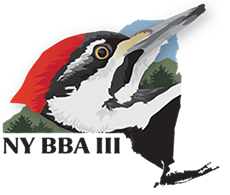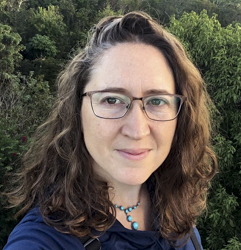
Atlas Birding
Learn how to observe bird behavior for better birding.
The Joys of Atlasing
by Julie Hart, NY BBA III Project Coordinator
New York Breeding Bird Atlas
If you're an eBird user, your contributions have powered research and conservation throughout the state and beyond, and 2020 brings another great way to enjoy birds: the third New York Breeding Bird Atlas! Breeding Bird Atlases (or BBAs) are dedicated efforts to understand the populations of breeding birds in a specific region. For the next 5 years, birders in New York will be going out throughout the state to document the breeding behaviors they observe, and we want you to be a part of it.
How can you join the fun?
All you have to do is go birding! The NY BBA III is fully integrated with eBird, so with a couple minor changes, you're essentially already atlasing!
 There are three things to keep in mind to be a part of the atlas:
There are three things to keep in mind to be a part of the atlas:
- The goal of the atlas is to document breeding behaviors using specific breeding codes. Understanding breeding codes is key.
- Atlas data are collected within 'atlas blocks'—square blocks that are around 3mi x 3mi in size. Keeping your traveling counts within a block is essential: if you reach the edge of a block, make sure to stop your checklist and start a new one.
- Once you understand breeding codes and the block boundaries, make sure to change your eBird portal to the NY BBA III for checklists with breeding codes. This is very easy, and there is a walkthrough of the process here.
If you have any more questions, please check out all eBird Atlas resources and stay informed by signing up for the atlas newsletter.
What is atlasing and how is it rewarding?
Atlasing is like regular birding but you slow down and observe the behaviors of individual birds. To help put this in perspective, I like to explain to people that I worked for several years doing various bird jobs around the country, but it wasn’t until I atlased in my home state that I was able to observe many of the breeding behaviors you read about in books. While blockbusting for the Vermont Breeding Bird Atlas, I was finally able to really enjoy the figure-eight courtship display of a Ruby-throated Hummingbird; was chased off a road by an angry Ruffed Grouse mother with chicks scurrying in every direction at her barking and growling and feigned injury display; observed Yellow-bellied Sapsuckers wriggling in and out of birch trees; and encountered countless thrushes with overstuffed bills full of worms and insects.
By the end of the summer I learned not only the alternate songs of most songbirds but also many of the call notes. I learned to distinguish amicable chatter between a pair from territorial squabbles. I started out knowing the large-scale habitat preferences of most species and a couple months later I recognized the small habitat differences that attract a Willow instead of an Alder Flycatcher. My understanding of bird behavior and identification skills of awkward, disheveled looking fledglings far exceeded what I thought possible. And it was all because I changed the way I birded. I slowed down and watched what the birds did. Sometimes I would sit and wait and not see any signs of breeding, but other times I had the most intimate glimpses into their daily lives. It was a continuously rewarding experience.
My experience is not unique. Many people express similar sentiments after they start atlasing; just ask your fellow bird club members who participated in the last atlas. Best of all, the delight that comes with this type of birding is open to all of us.
How do I practice atlasing and entering my observations in eBird?
Some birds are already nesting, while others are courting and setting up territories. Start small by watching the birds in your backyard or favorite park. If you see a behavior and you don’t know what it means, look it up. The Cornell Lab’s “All About Birds” site is a good place to start. If it turns out to be a breeding behavior, note the behavior on your checklist.
NY BBA III will be using eBird for data entry, so start getting comfortable with eBird. Check out the free “eBird Essentials” course offered by the Cornell Lab of Ornithology, teach yourself by following the eBird tutorials for web and mobile, or ask a fellow birder to show you how to get started. Once you are familiar with eBird, start adding breeding observations to your checklists. Go to the detailed section for each species on your checklist and select the appropriate breeding code. Whether you use mobile or web, it’s just a few extra clicks.
We will cover more detail on the different breeding codes in future articles. We will also cover how to make sure you are entering observations within an atlas block and other tips to make your checklists more useful for data analysis. Until then, have fun exploring the joys of atlasing!
This article first appeared in New York Birders, a publication of NYSOA.
Breeding Codes
Breeding observations are very important to our database, so it's important that you understand breeding codes. Please check out these articles, which will help you learn all about the different categories of breeding evidence and The Holy Grail: confirmed breeding!
Breeding Codes - Part 1: Confirmations
Breeding Codes - Part II:
Possibles and Probables
About Atlas Project Coordinator, Julie Hart
By Kathryn Schneider, Co-chair, NY BBA III Steering Committee
The Steering Committee for New York’s third Breeding Bird Atlas has been meeting since 2015 to fund, organize, and plan our next bird atlas. This project will provide a five-year snapshot of the distribution and abundance of breeding birds in New York State. The committee is excited to announce that Julie Hart has been hired to fill the position of Atlas Project Coordinator. Julie beat out an outstanding field of nearly 80 applicants who sought this position. She impressed the Search Committee with her combination of scientific training, field work, large-scale citizen science, and project management experience.
Some New York birders will remember Julie from the years she spent in New York working on the Important Bird Areas program with Audubon New York. During this time, she was based at the Cornell Lab where she had the opportunity to work on eBird during its development. From 2007 to 2009 Julie was a Conservation Biologist for the Vermont Center for Ecostudies. In this position she recruited, trained, and organized more than 150 volunteers for Mountain Birdwatch, a project that monitors high-elevation birds in New York, Vermont, New Hampshire, and Maine.
 Julie has participated in bird atlases in Vermont and Connecticut and she has trained volunteers to use eBird. Her most recent position as a Database Manager for Yale’s Map of Life project involved managing large datasets not unlike those generated by a bird atlas.
Julie has participated in bird atlases in Vermont and Connecticut and she has trained volunteers to use eBird. Her most recent position as a Database Manager for Yale’s Map of Life project involved managing large datasets not unlike those generated by a bird atlas.
Julie hit the ground running and attended her first Steering Committee meeting after only four days on the job. She will work in DEC offices in Albany as a part of the staff of the New York Natural Heritage Program and she will be officially supervised by Matt Schlesinger, Co-chair of the NY BBA III Steering Committee.
Everyone on our committee is delighted to have an individual on the team whose sole responsibility is the management and coordination of the Atlas Project, but we all know that the success of a project as large, complex, collaborative, and long term as our state atlas depends first and foremost on large numbers of skilled volunteers to gather the data. In the coming year we will be asking birders to commit to field surveys using Atlas methodology. We are relying on you to get involved! We will want you to go places that you’ve never been before, and we will need you to watch and document the birds you see in new and different ways. Are you up to the challenge?